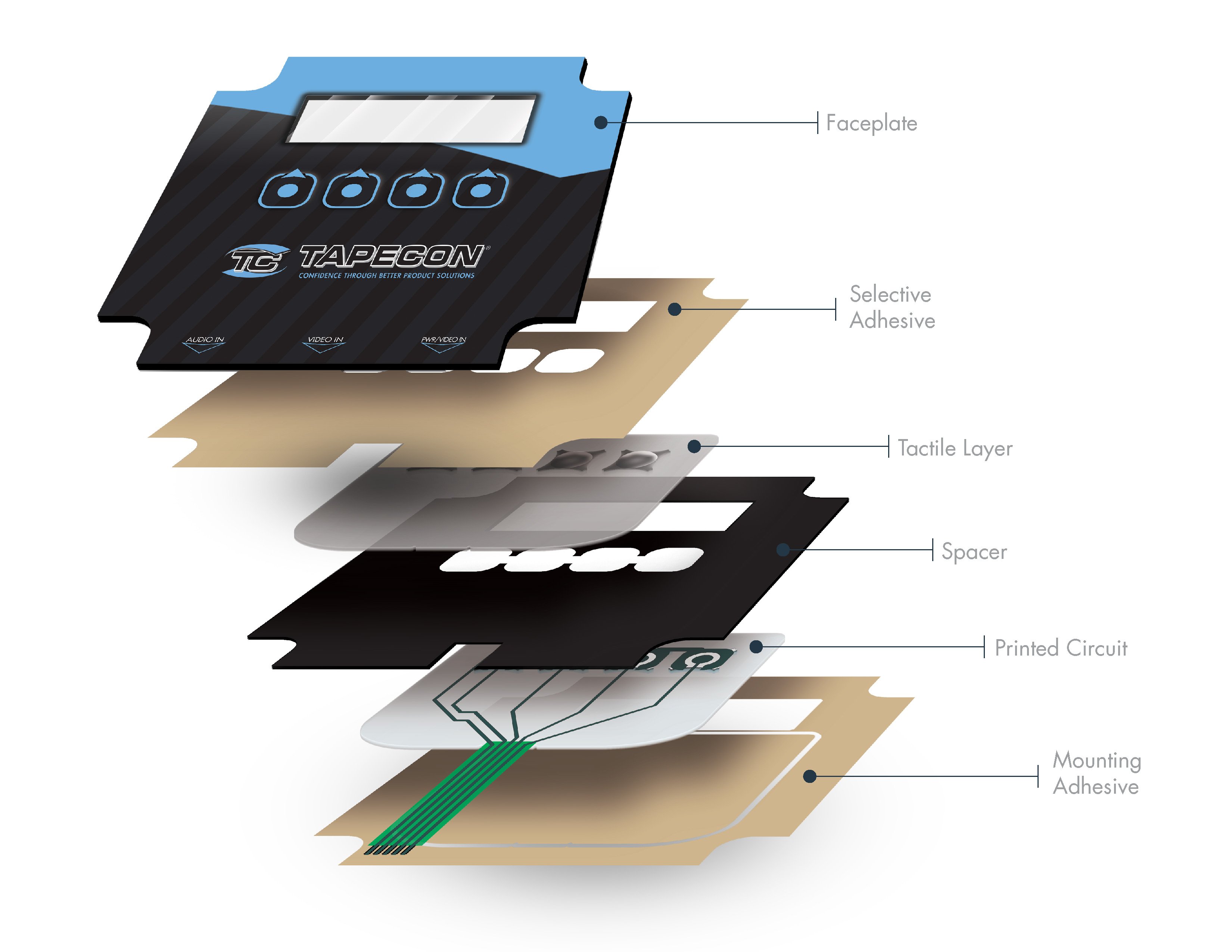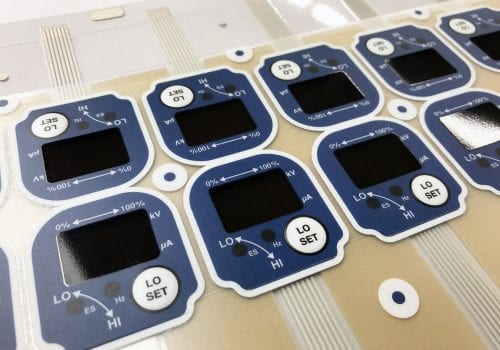All Concerning Membrane Switch Over: A Comprehensive Overview for Beginners
Membrane buttons are essential components in contemporary electronic devices, providing a distinct interface for customer interaction - membrane switch. Their split building, including overlays and conductive traces, gives performance and durability. Unlike standard mechanical buttons, membrane buttons offer a streamlined style and adjustable choices. Understanding their key functions and benefits can transform item design. The ins and outs of their application and style factors to consider require additional expedition.
What Is a Membrane layer Change?
A membrane layer switch is a type of electric switch that consists of an adaptable membrane layer layered over a published circuit board. This layout enables a compact and streamlined interface, commonly utilized in different digital gadgets. Membrane layer switches are typically discovered in consumer appliances, clinical tools, and commercial equipment because of their resilience and resistance to environmental factors.The building typically includes numerous layers, such as graphic overlays and glue backing, which give tactile comments and protect the wiring beneath. The procedure of a membrane switch is launched when stress is applied to the surface area, finishing an electric circuit.These buttons are valued for their versatility, making it possible for custom styles and published graphics that satisfy certain interface. Their inconspicuous nature reduces area needs, making them excellent for applications where conventional switches might not fit. In general, membrane buttons supply a useful and aesthetic solution for contemporary digital tools.
Trick Components of Membrane Layer Switches
Membrane switches over make up a number of vital parts that contribute to their capability and performance. The leading layer, referred to as the overlay, gives the interface and is typically published with icons or graphics. Below the overlay lies a spacer layer, which separates the conductive components and stops unintended activation. The following essential element is the graphic layer, which improves appearances and assures the resilience of the design.Conductive traces, usually made from products like silver or carbon, are printed on the circuit layer. When pressure is used to the overlay, these traces come into contact, finishing the circuit. Additionally, a backing layer offers structural support and can be made from products such as polyester or polycarbonate. Together, these components create a dependable, straightforward interface ideal for different applications, from home appliances to commercial equipment. Understanding these components is vital for anybody thinking about membrane switch modern technology.
How Membrane Changes Job
Recognizing how membrane layer changes function is important for appreciating their widespread use in different tools. A membrane button operates through a series of layers, including a graphic overlay, spacer, and a circuit layer. When pressure is used to the overlay, it presses the spacer layer, permitting the circuit layer to make contact and complete an electric circuit. This action sends a signal to the gadget, prompting a feedback, such as turning on a light or triggering a function.Membrane switches can be created with numerous attributes, consisting of tactile feedback, backlighting, and personalized graphics, boosting customer communication. Their building and construction permits a closed style, safeguarding the internal parts from dirt, moisture, and contaminants. This sturdiness makes them suitable for varied applications, from consumer electronic devices to commercial equipment. Overall, the simplicity and effectiveness of membrane switches over add to their appeal in contemporary technology.
Advantages of Membrane Layer Switches Mechanical Buttons
While mechanical switches have actually long been a staple in many gadgets, membrane switches over deal distinctive benefits that make them significantly appealing. One significant advantage is their slim profile, enabling more compact layouts and better versatility in product growth. In addition, membrane layer changes attribute an uniform surface, which improves aesthetic charm and simplifies cleansing, making them suitable for atmospheres where health is critical.Another advantage is their resistance to dirt and wetness. Unlike mechanical buttons, which can be endangered by environmental variables, membrane switches supply a closed user interface that secures versus contaminants - membrane switch. Furthermore, membrane buttons usually have a longer lifespan because of less relocating components, causing enhanced toughness and reliability.Cost-effectiveness is additionally a notable advantage, as membrane switches can be created wholesale with lower production costs. These elements incorporate to place membrane buttons as a useful alternative to traditional mechanical choices in numerous applications
Common Applications of Membrane Layer Changes
Membrane layer buttons are extensively used in numerous markets, particularly in customer electronics and industrial control panels. In consumer devices, they supply a smooth, straightforward user interface, while in commercial settings, they enhance toughness and performance. Comprehending these applications highlights the convenience and practicality of membrane switches in modern-day innovation.
Customer Electronic Devices Tools
As customer electronic devices continue to advance, membrane layer buttons have actually become a preferred choice for a range of tools as a result of their flexibility and smooth style. These switches are generally discovered in smart devices, tablets, and remotes, where area is limited and appearances issue. Their reduced account and customizable layouts permit manufacturers to produce straightforward user interfaces that enhance the overall individual experience. Furthermore, membrane switches are frequently made use of in appliances such as microwaves and coffee makers, offering user-friendly control options while standing up to dampness and dust. The toughness and integrity of membrane layer changes make them appropriate for everyday customer products, guaranteeing durability and consistent efficiency. Overall, their assimilation in consumer electronic devices reflects a blend of functionality and contemporary layout.
Industrial Control Panels
The applications of membrane switches expand past customer electronics, discovering significant usage in commercial control panels. These switches are favored for their toughness and resistance to severe settings, making them excellent for producing and procedure control setups. They provide a reliable user interface for operators to manage equipment, display processes, and readjust setups. Membrane buttons can be customized to suit specific operational requirements, incorporating attributes like backlighting and tactile responses, boosting customer experience. Their inconspicuous style permits for combination right into various devices, while their ability to hold up against spills, dirt, and severe temperatures assurances long life. Overall, membrane layer buttons add to reliable and safe operation in industrial applications, showing their flexibility and effectiveness find here sought after environments.
Considerations for Creating Membrane Switches Over
When designing membrane switches, selecting the ideal products is vital to ensure longevity and functionality. Additionally, comprehending layer arrangement techniques can significantly impact the switch's efficiency and individual experience. These factors to consider play a vital role in producing efficient and dependable membrane switch styles.
Material Selection Significance
Material selection plays a vital role Go Here in the design and functionality of membrane switches. The chosen products directly impact the switch's sturdiness, tactile feedback, and total aesthetic. Key considerations consist of the substrate, which must supply architectural stability while permitting versatility, and the visuals overlay, which needs to be immune to wear and environmental factors. Conductive products ought to assure reliable electric efficiency, while adhesives must offer solid bonding without endangering the button's procedure. Additionally, compatibility with making processes and end-user environments is vital; products need to stand up to differing temperature levels, moisture degrees, and chemical exposure. Ultimately, appropriate material selection not just boosts the membrane switch's performance yet likewise contributes to its long life and customer satisfaction, making it an essential element of the design procedure.

Layer Configuration Strategies

Often Asked Inquiries
For How Long Do Membrane Switches Over Usually Last?
Membrane layer switches usually have a lifespan of 1 to 5 million cycles, relying on usage and environmental conditions. Variables such as style top quality and operating regularity greatly affect their resilience and total performance durability.

Can Membrane Layer Changes Be Personalized for Specific Styles?
Membrane buttons can indeed be customized to accommodate specific layouts, permitting diverse forms, colors, and capabilities. This flexibility makes it possible for suppliers to customize these switches to meet one-of-a-kind visual and operational requirements properly.
What Materials Are Used in Membrane Layer Change Building And Construction?
Membrane buttons are generally created making use of materials such as polyester, polycarbonate, and glue layers. These materials give resistance, versatility, and durability to environmental variables, guaranteeing the buttons function efficiently in numerous applications and problems.
Are Membrane Switches Over Resistant or water-proof to Dampness?
Membrane layer switches can be developed to be moisture-resistant, using specialized products and layers. Their waterproof abilities depend on building high quality and certain applications, making it crucial to assess requirements for excellent performance in various settings.
Exactly How Are Membrane Layer Switches Over Repaired if Damaged?
Repairing damaged membrane layer switches over commonly includes changing the influenced layer or circuit. Professionals might likewise apply conductive adhesive or utilize specialized fixing packages, making certain performance is brought back without full substitute of the whole button setting up. Unlike conventional mechanical buttons, membrane layer switches present a sleek layout and personalized options. A membrane switch is a type of electric switch that is composed of a flexible membrane layer layered over a printed circuit board. The operation of a membrane button is started when pressure is used to the surface, completing an electric circuit.These buttons are valued for their convenience, making it possible for custom-made styles and printed graphics that provide to particular user interfaces. While mechanical buttons have actually long been a staple in numerous devices, membrane layer changes offer distinctive advantages that make them increasingly appealing. Membrane layer switches generally have a longer life expectancy due to fewer relocating parts, resulting in improved resilience and reliability.Cost-effectiveness is likewise a noteworthy advantage, as membrane switches can be generated in bulk with reduced manufacturing expenses.